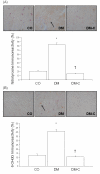Differential effects of curcumin on vasoactive factors in the diabetic rat heart
- PMID: 16848894
- PMCID: PMC1543622
- DOI: 10.1186/1743-7075-3-27
Differential effects of curcumin on vasoactive factors in the diabetic rat heart
Abstract
Background: Increased oxidative stress has been associated with the pathogenesis of chronic diabetic complications, including cardiomyopathy. Recent studies indicate that curcumin, a potent antioxidant, may be beneficial in preventing diabetes-induced oxidative stress and subsequent secondary complications. We have investigated the effects of curcumin on the nitric oxide (NO) pathway in cardiac tissues and cultured cells.
Methods: Streptozotocin-induced diabetic rats were treated with curcumin for a period of one month. Heart tissues were then analyzed for endothelial NO synthase (eNOS) and inducible NO synthase (iNOS) mRNA expression. Oxidative protein and DNA damage were assessed by immunohistochemical analysis of nitrotyrosine and 8-hydroxy-2'-deoxyguanosine (8-OHdG). Heart tissues were further subjected to endothelin-1 (ET-1) mRNA expression. In order to further characterize the effects of curcumin, we assayed microvascular endothelial cells (MVECs). Cultured MVECs, exposed either to glucose or glucose and varying concentrations of curcumin, were assessed for alterations of NOS expression and activation of nuclear factor-kappaB (NF-kappaB) and activating protein-1 (AP-1). Oxidative stress and ET-1 expression levels were also assayed.
Results: Our results indicate that one month of diabetes causes an upregulation of both eNOS and iNOS mRNA levels, and nitrotyrosine and 8-OHdG immunoreactivity in the heart. Treatment of diabetic rats with curcumin reduced eNOS and iNOS levels in association with reduced oxidative DNA and protein damage. Interestingly, curcumin further increased vasoconstrictor ET-1 in the heart. Exposure of MVECs to high glucose increased both eNOS and iNOS levels and oxidative stress. Curcumin prevented NOS alteration and oxidative stress in a dose-dependent manner which was mediated by nuclear factor-kappaB and activating protein-1. Exposure to curcumin also increased ET-1 levels in the MVECs.
Conclusion: Our studies indicate the differential effects of curcumin in vasoactive factor expression in the heart and indicate the importance of tissue microenvironment in the treatment of diabetic complications.
Figures




Similar articles
-
Glucose-induced up-regulation of CD36 mediates oxidative stress and microvascular endothelial cell dysfunction.Diabetologia. 2005 Jul;48(7):1401-10. doi: 10.1007/s00125-005-1801-8. Epub 2005 May 25. Diabetologia. 2005. PMID: 15915335
-
Curcumin Attenuates Retinal Vascular Leakage by Inhibiting Calcium/Calmodulin-Dependent Protein Kinase II Activity in Streptozotocin-Induced Diabetes.Cell Physiol Biochem. 2016;39(3):1196-208. doi: 10.1159/000447826. Epub 2016 Sep 5. Cell Physiol Biochem. 2016. PMID: 27595397
-
Curcumin prevents diabetes-associated abnormalities in the kidneys by inhibiting p300 and nuclear factor-kappaB.Nutrition. 2009 Sep;25(9):964-72. doi: 10.1016/j.nut.2008.12.007. Epub 2009 Mar 5. Nutrition. 2009. PMID: 19268536
-
Effects of a selective endothelin a receptor antagonist on the expressions of iNOS and eNOS in the heart of early streptozotocin-induced diabetic rats.Exp Biol Med (Maywood). 2006 Jun;231(6):925-31. Exp Biol Med (Maywood). 2006. PMID: 16741025
-
N-acetylcysteine prevents nitrosative stress-associated depression of blood pressure and heart rate in streptozotocin diabetic rats.J Cardiovasc Pharmacol. 2006 Apr;47(4):513-20. doi: 10.1097/01.fjc.0000211744.93701.25. J Cardiovasc Pharmacol. 2006. PMID: 16680064
Cited by
-
Curcumin ameliorates high glucose-induced neural tube defects by suppressing cellular stress and apoptosis.Am J Obstet Gynecol. 2015 Jun;212(6):802.e1-8. doi: 10.1016/j.ajog.2015.01.017. Epub 2015 Jan 13. Am J Obstet Gynecol. 2015. PMID: 25595578 Free PMC article.
-
The Underlying Mechanisms of Curcumin Inhibition of Hyperglycemia and Hyperlipidemia in Rats Fed a High-Fat Diet Combined With STZ Treatment.Molecules. 2020 Jan 9;25(2):271. doi: 10.3390/molecules25020271. Molecules. 2020. PMID: 31936547 Free PMC article.
-
Cytoprotective Effects of Natural Compounds against Oxidative Stress.Antioxidants (Basel). 2018 Oct 20;7(10):147. doi: 10.3390/antiox7100147. Antioxidants (Basel). 2018. PMID: 30347819 Free PMC article. Review.
-
Histological evidence of chitosan-encapsulated curcumin suppresses heart and kidney damages on streptozotocin-induced type-1 diabetes in mice model.Sci Rep. 2019 Oct 23;9(1):15233. doi: 10.1038/s41598-019-51821-6. Sci Rep. 2019. PMID: 31645652 Free PMC article.
-
Novel curcumin analog C66 prevents diabetic nephropathy via JNK pathway with the involvement of p300/CBP-mediated histone acetylation.Biochim Biophys Acta. 2015 Jan;1852(1):34-46. doi: 10.1016/j.bbadis.2014.11.006. Epub 2014 Nov 11. Biochim Biophys Acta. 2015. PMID: 25446993 Free PMC article.
References
-
- Garcia MJ, McNamara PM, Gordon T, Kannel WB. Morbidity and mortality in diabetics in the Framingham population. Sixteen year follow-up study. Diabetes. 1974;23:105–111. - PubMed
-
- Role of cardiovascular risk factors in prevention and treatment of macrovascular disease in diabetes. American Diabetes Association. Diabetes Care. 1989;12:573–579. - PubMed
-
- Hayat SA, Patel B, Khattar RS, Malik RA. Diabetic cardiomyopathy: mechanisms, diagnosis and treatment. Clin Sci (Lond) 2004;107:539–557. - PubMed
LinkOut - more resources
Full Text Sources
Other Literature Sources
Research Materials

